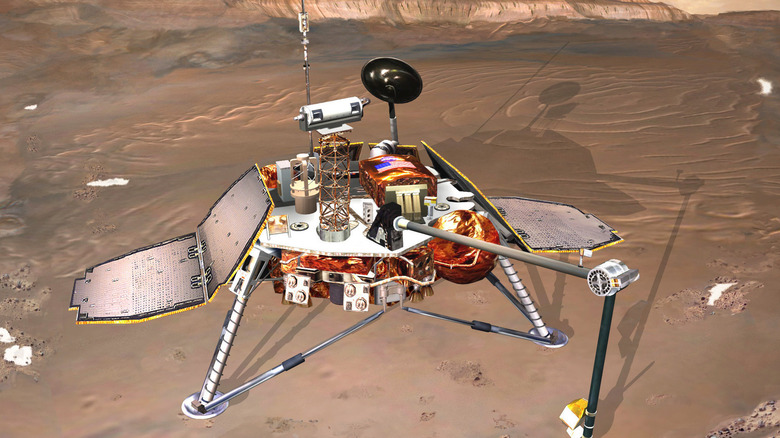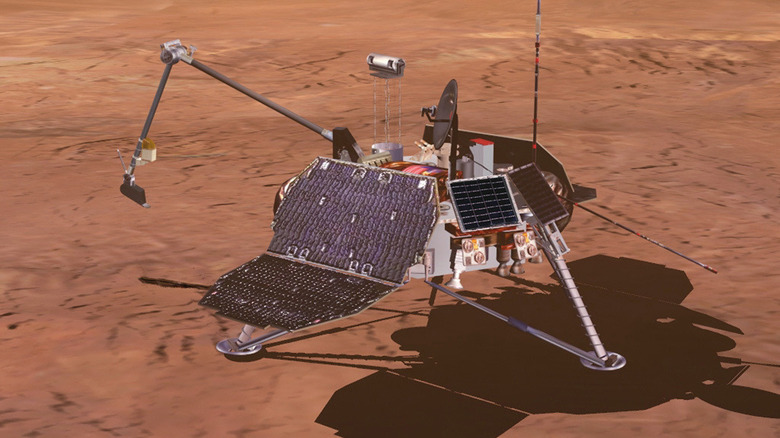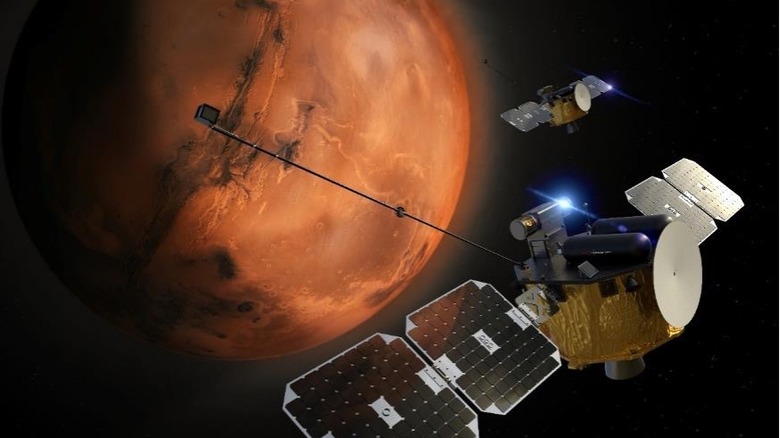NASA's Failed Mars Missions That Cost Over $200 Million
On January 3, 1999, NASA launched what was going to be an exciting new mission to Mars: the Mars Polar Lander. Designed to study the soil and climate of Mars' southern pole, the lander was accompanied by two smaller probes called Deep Space 2, which were intended to slam into the planet's surface at high speed and study the soil up close. The lander traveled through space as planned and arrived at Mars on December 3, 1999. The mission began the landing procedure and entered the atmosphere, but it never made contact again. The mission was declared lost and assumed to have crashed into the planet.
There wasn't any telemetry data to see exactly what happened, but subsequent investigation found that sensors in the landing gear were sending out false readings and that this fault was not discovered in testing (via Space Ref). This was blamed on an insufficient budget for the mission and inefficient communication. According to AP, the total cost of the collective mission including development and operations for both the Mars Polar Lander and the accompanying Deep Space 2 was $194.6 million in 1999. Calculated for inflation, that's over $340 million in 2022's dollars, according to U.S. Inflation Calculator.
The problem with faster, better, cheaper
The Mars Polar Lander — along with another Mars mission that was lost in the 1990s, the Mars Climate Orbiter — was launched under a NASA program called "Faster, Better, Cheaper." The idea of the program was to streamline the production of space missions and cut down on red tape, according to Elizabeth A. Frank. The approach had successes in its early years, like the Mars Pathfinder and Mars Global Surveyor missions. But today, it is most remembered for the failures of the Mars Polar Lander and Mars Climate Orbiter missions, the combined total of which cost almost $236 million, according to CNN.
The "Report on the Loss of the Mars Polar Lander and Deep Space 2 Missions" [PDF] by NASA's Jet Propulsion Laboratory, which built the Mars Polar Lander, found that there were in fact a number of problems with the design of the mission, any of which could have resulted in it being lost. The lack of a full "system-level qualification test" before launch was singled out as a particular problem.
Some people have argued that despite the high-profile failures, the Fast Better Cheaper program did in fact produce more science per dollar than other programs. To some extent the issue is one of balancing risk and public perception — it may make financial sense to send out cheaper, higher-risk missions, but the stigma of failed missions tends to make the public skeptical about space exploration. "We perceive many lasting benefits to current projects today from the adoption of the stretch goal of completing projects 'Faster-Better-Cheaper' in the 1990s and perceive that NASA suffers from a bias against learning from the FBC era because of the stigma of the failed projects," a report about the era from 2014 states (via IEEE).
Looking to the future
Even though the Faster Better Cheaper era is often looked back on as a failure, there are signs that NASA is becoming interested in using a similar approach in a smaller-scale way. Missions like EscaPADE, which will send a pair of satellites to Mars to study its magnetosphere, are designed to be extremely cheap — in this case, at under $80 million total for the mission, according to USRA [PDF], including launch, which is a fraction of what a Mars mission would normally cost. One way costs are being cut is by reducing the amount of testing and redundancy done on the EscaPADE hardware. That ups the risk of the mission failing but makes it much cheaper.
"Just like any savvy investor, NASA is putting one or two percent of their portfolio into something that potentially has a much higher science per dollar return, in exchange for accepting somewhat higher risk," EscaPADE Principle Investigator Rob Lillis explained to Supercluster. The main thrust of NASA's approach to Mars in the next decade will continue to be on the very expensive Mars Sample Return mission, but there may also be opportunities for lower-cost missions, as well.


